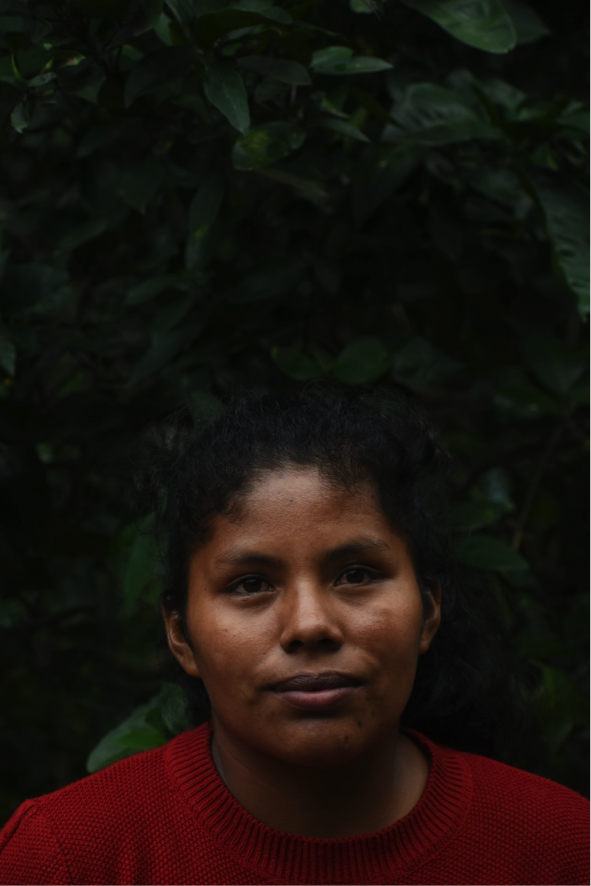ESTELA RAMOS APAZA IS 56 YEARS OLD. SHE SPENT A GOOD PART OF HER LIFE HARVESTING COCA IN LA ASUNTA, BUT IS NOW IN POLITICS BECAUSE SHE WANTED TO BREAK AWAY FROM THE ONLY WAY OF LIFE THAT WAS AVAILABLE TO HER.
THE “TAQUES”, LARGE BAGS OF COCA LEAVES, ARE READY TO BE TRANSPORTED TO THE CITY OF LA PAZ. THEY’RE THE BEST SOURCE OF INCOME FOR COMMUNITIES IN THESE RURAL AREAS. COMMUNITY OF CHAMACA, LA ASUNTA.
MYRIAM CHOQUE CRUZ’S CASE FILE CONTAINING HER PSYCHOLOGICAL EVALUATION AND FORENSIC ANALYSIS WHICH FOUND EVIDENCE OF PHYSICAL VIOLENCE. THE LAST PAGES INCLUDE HER DEATH CERTIFICATE.
DURING THE MEETING, THE WOMEN CHEWED COCA MIXED WITH LYE, A SWEET MADE FROM WOOD ASHES.
NAJHELY BUSTAMANTE IS A 13-YEAR-OLD GIRL WHO TOOK PART IN THE WORKSHOP. HER ADMIRABLE ELOQUENCE AND CONFIDENCE MADE HER STAND OUT.
FAUSTINA CARREÑO IS ONE OF THE LEADERS OF THE WOMEN'S UNION IN LA ASUNTA. TOGETHER WITH HER FELLOW MEMBERS, SHE FIGHTS TO MAINTAIN THE DIGNITY OF COCA GROWING WOMEN IN THE AREA.
ÉRIKA'S POSTER.
ESTELA RAMOS APAZA IS 56 YEARS OLD. SHE SPENT A GOOD PART OF HER LIFE HARVESTING COCA IN LA ASUNTA, BUT IS NOW IN POLITICS.

FAUSTINA'S BAGS OF COCA READY TO BE TAKEN TO THE CITY OF LA PAZ.
NOEMÍ PRIETO, ONE OF THE PARTICIPANTS IN THE WORKSHOP, MIGRATED FROM THE MINING REGION OF ORURO TO LA ASUNTA GROW COCA WITH HER HUSBAND.
THROUGH THE TRADE UNION AND HER POSITION IN THE LOCAL COUNCIL, ESTELA HAS DEVELOPED WORKSHOPS TO PREVENT VIOLENCE AGAINST WOMEN, ENCOURAGED DEBATES ON MENTAL AND PHYSICAL WELL-BEING AND PROMOTED SUSTAINABLE AGRICULTURE IN LA ASUNTA.
NOEMÍ LEAVING HER COCA PLANTATION. DESPITE THE DIFFICULTIES OF BEING A FEMALE UNION LEADER, SHE SAID EXPERIENCES LIKE THE WORKSHOP HAVE REKINDLED HER PASSION TO HELP WOMEN WHO EXPERIENCE DOMESTIC VIOLENCE.
THE MUNICIPALITY OF LA ASUNTA IS A MIGRATION HUB – MOST OF THE POPULATION COMES FROM ELSEWHERE. WALKING AROUND THE DIFFERENT COMMUNITIES IN THE AREA, YOU CAN SEE ENTIRE MOUNTAINS OF COCA LEAF PLANTATIONS, THE MAIN SOURCE OF INCOME FOR MANY FAMILIES.
ÉRIKA DRYING COCA LEAVES.
Coca has been used for millennia by indigenous communities in the Andes for medicinal and ritual purposes. The plant is part of the local identity and traditions.
NAJHELY BUSTAMANTE WITH HER MOTHER, VIVIANA DELGADO, AND HER YOUNGER SISTER IN THEIR COCA PLANTATIONS.
IN BOLIVIA AND PERU, THERE ARE MORE THAN EIGHT MILLION CONSUMERS OF TRADITIONAL COCA LEAF. EVERY FAMILY IN LA ASUNTA CONSUMES COCA IN THE TRADITIONAL WAY.